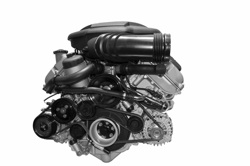A magazine where the digital world meets the real world.
On the web
- Home
- Browse by date
- Browse by topic
- Enter the maze
- Follow our blog
- Follow us on Twitter
- Resources for teachers
- Subscribe
In print
What is cs4fn?
- About us
- Contact us
- Partners
- Privacy and cookies
- Copyright and contributions
- Links to other fun sites
- Complete our questionnaire, give us feedback
Search:
Driven to perfection

The motor car is part and parcel of modern life, but cars can have a massive impact on the environment, from exhaust fumes to guzzling petrol. Car manufacturers are increasingly looking at ways to make cars greener. As the rules on allowable levels of exhaust emissions get tighter, the need to make the most of the world’s dwindling supply of fossil fuels becomes more pressing. Material engineers develop lighter alloys to build cars with, chemists develop catalytic converters to remove some of the toxic nastiness in exhausts, electronic engineers work to develop efficient new electric engines, and computer scientists chip in by trying to make our vehicles smarter.
The bang, bang, bang of a banger
Today’s motor vehicles, on the whole, use the same basic internal combustion engine that’s been around for more than a century, and produced many happy hours of engine tinkering in the past. It gets its drive from a series of cylinders with plunger-like pistons inside, held within the engine block. The fuel injection squirts petrol into a cylinder, which mixes with air. The spark plug ignites this mixture and bang – the mixture explodes, pushing the piston. The pistons attached to the different cylinders are all connected to the crank shaft. This cleverly designed bit of zigzagged metal ensures that as one cylinder ignites, pushing its piston downwards and causing the crank shaft to rotate, another of the pistons attached to the crank shaft is forced up in turn. The petrol-air mixture in this cylinder is then ignited and so on in a repeating cycle, each explosion triggering the next phase as the crank shaft continues to turn.

Have a break, have a smart engine
Until recently all a car’s cylinders were used all the time, but that can waste fuel. The crank shaft is turning at top speed but the road speed, fixed by the gear you’re in, may be much less. You may even be stopped at traffic lights or stuck in a traffic jam, but the crank shaft still spins on regardless. The smart engine management system fixes that. Onboard computers monitor the speed you want to go and reduce the amount of fuel in the cylinders when you don’t need that extra power. The smart cylinders take a break. In some smart engines it’s even more extreme. When you’re stationary the computer system turns the engine off altogether, but allows it to spring back into life the instant you need it. The same smart computer control has been even applied to the engines in motorbikes where computers control the electronic valves on the cylinders, ensuring that performance is there when you need it, but precious fuel isn’t wasted.
Reinventing the wheel
It’s not just the car engine that can get smarter to go greener – the wheels can too. Scientists at the University of Portsmouth's Institute of Industrial Research have given car wheels the ability to learn the best driving style for a given speed and road condition. The wheels contain a microcomputer and sensors that allow them to detect the road conditions under them; they can also communicate with the other wheels on the car to see how things are on the other corners of the vehicle. All this information is processed by onboard software, and this artificial intelligence changes the car suspension, steering and braking systems accordingly. These smart wheels can learn how to change the car’s driving performance depending on the road you’re driving. After all, you’re going to drive differently over a bumpy, winding country road and a rain-covered motorway. As the car learns it also remembers, and if in future the wheels sense that they are in the same situation, the car’s memory changes the way it handles to ensure a safe and fuel efficient drive.


